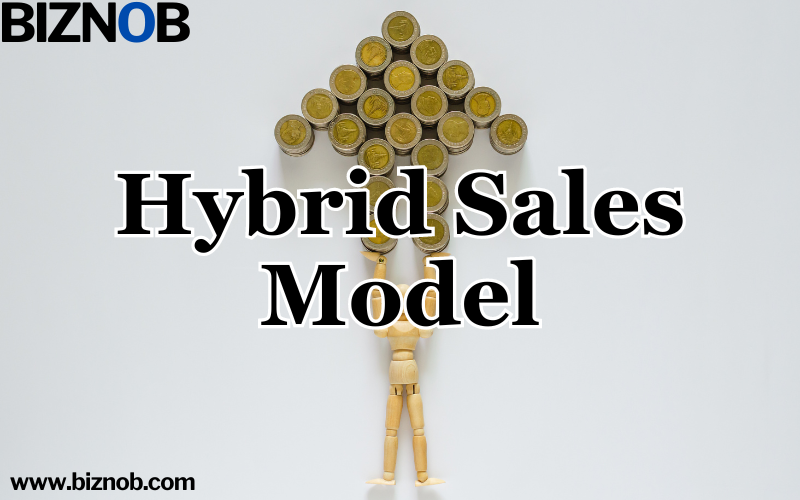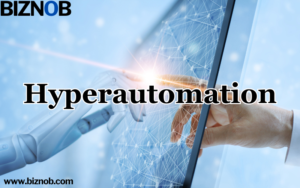What Is a Hybrid Sales Model?
A hybrid sales model combines online and offline sales platforms and strategies to create a flexible way to get a more significant market share. This model isn’t just a mix of different sales strategies; it’s a carefully planned combination that aims to maximize the best parts of both digital and traditional sales platforms. The hybrid sales model stands out in a market that is becoming more digital and values personalized interactions because it can adapt to different customer paths.
The model isn’t just a reaction to how the market is right now; it’s also a plan for the future that plans to adapt to changing market conditions and customer needs. It helps businesses stay strong, current, and able to give their customers value through personalized shopping experiences.
Synonyms
- Hybrid sales strategy
- Integrated sales approach
How the Hybrid Sales Model Works
To learn more about the mixed approach to selling, you need to look into its essential parts and traits, which work together to make a solid and adaptable sales strategy.
What makes hybrid sales work, and what do they look like?
The hybrid sales model is unique because it can combine different sales elements without problems. This ensures the buyer is engaged across all channels and throughout the buying process. Online marketing and virtual sales meetings are examples of digital sales tactics. Traditional sales tactics include face-to-face meetings and sales in stores. The model focuses on making things easy for customers by providing a variety of connections and ways for them to interact with the model.
How Hybrid Sales Are Different from Traditional Sales Models
Traditional sales models may focus on either offline or online platforms most of the time. The hybrid sales model is different because it uses both. Businesses aren’t limited to a single sales avenue; they can use several different ones to reach potential customers. The model helps make sales more personalized and focused on the customer, ensuring that businesses can respond quickly to changes in the market and customer wants.
How sales models have changed over time
In the past, standard sales models focused on face-to-face interactions and were very localized. However, the digital age brought about a considerable change. Online platforms, e-commerce, and digital marketing tools let companies reach customers worldwide, regardless of location.
The introduction of CRM systems, AI, and data analytics, among other technological advances, has completely changed how sales are made. With these tools, it’s easier to take a data-driven approach, which helps businesses make more personalized and focused sales strategies by learning about how customers behave and what they like. Also, social media and internet platforms have opened up new, real-time ways for businesses to interact with and help customers. Here are some examples of companies that have successfully implemented:
For example, IBM
IBM, a global tech and consulting firm, has cleverly used a hybrid sales model to deal with the problems that the market’s digital transformation has brought up. By combining their online and offline sales channels, IBM has made it easier for business customers to access and use their products. This lets customers connect with the brand in a way that suits their needs and preferences. IBM’s hybrid model lets them contact more people online while maintaining close ties with current clients through face-to-face meetings.
For instance, Best Buy
Best Buy, a global electronics store, used the hybrid sales model to reach more customers. It did this by using digital platforms to reach new groups of customers while keeping its old-fashioned sales channels open to serve its current customers. When e-commerce took off, Best Buy combined its online and offline services to serve the growing digital market. It now lets customers order online and pick up their purchases in-store. They kept their physical stores open simultaneously to serve customers who wanted to shop in person. Omnichannel selling helped the company find a good balance between the two selling methods, ensuring that brand engagement was the same across all platforms.
Putting in place a hybrid sales model
Starting a hybrid sales model requires a planned and organized approach. This is to ensure that businesses know how to combine digital and traditional sales methods to improve customer involvement and sales performance.
First Step: Figure Out Which Groups of Customers You Want
Knowing your target customer groups’ social and psychological traits is essential. Businesses should look into how customers act, what they like, and how often they buy things. They can use sales analytics to develop strategies that work for a wide range of customer groups across all sales platforms.
Step 2: Picking the Right Sales Channels
To pick the best sales outlets, you must look at how well and far both digital and traditional platforms can reach. Businesses should look at the potential of different channels, like direct sales, social media, e-commerce platforms, and natural stores, and make sure they match the likes and dislikes of their target customer groups.
Step 3: Putting together sales strategies
When you combine digital and traditional sales methods, you should do it in a way that makes sure everything is consistent and works well together. Businesses should ensure customers have the same brand experience whether they interact with the business online or offline. This includes everything from price strategies to marketing messages.
Step 4: Make a Customer Journey That Makes Sense
Planning a seamless customer journey between online and offline platforms is essential. Businesses should make it easy for customers to switch between digital and physical platforms. This will keep the buying process going smoothly and improve customers’ overall experience and happiness.
Step 5: Putting technology solutions into action
Technology solutions like AI and CRM systems can digitally change the sales organization, making mixed sales teams more effective and efficient. These tools can help businesses handle and improve their sales funnels by making tracking sales, interacting with customers, and managing data easier.
Step 6: Get trained and grow
Ensuring that salespeople know how to use digital and traditional sales platforms well is essential. Training programs should focus on building skills and knowledge in areas like customer relationship management, data analytics, and digital interactions to make sure that the team can connect customers effectively across all platforms.
Step 7: Testing and studying how healthy sales are going
Businesses can determine how well their hybrid sales strategy works by using metrics and key performance indicators (KPIs) to track and evaluate sales across different channels. Data analytics should be used to look at things like sales performance, sales cycles, customer engagement, and conversion rates. This will give you information you can use to improve your sales plan.
Step 8: Always make things better
Hybrid selling is constantly tweaked to fit changing customer tastes and market trends. The model should be reviewed and improved regularly to ensure it is current, competitive, and can boost sales and build long-term customer relationships.
The good and bad points of the hybrid sales model
Hybrid selling has many pros and cons, and each significantly affects the sales strategy and how you connect with customers.
Why using a hybrid sales strategy is a good idea.
Businesses can get several benefits from using a hybrid sales approach, such as:
Better customer reach
This approach increases market penetration and makes products more accessible to a broader range of customers through online and offline channels.
Being able to bend and adapt
It allows you to change your strategies to keep up with changing customer habits and market trends to stay relevant.
Personalized Service for Customers
By interacting with people on multiple platforms, you can gather information that you can use to personalize their experiences and make them happier.
Multiple ways to make money
Because it’s not tied to a single sales effort, the plan makes the business more financially stable and resistant to changes in the market.
Possible Problems and Drawbacks
The mixed sales model has many great things, but it also comes with several problems and issues that businesses must deal with.
Management That Is Too Hard
Managing multiple sales outlets requires muscular coordination, marketing, and pricing that are the same for all.
Using a lot of resources
Significant investments may need to be made in technology, training, and management tools to ensure the model is implemented and managed well.
Chance of Inconsistencies
Keeping the same brand identity and customer experience across digital and traditional outlets can be hard and requires careful management.
Problems with Technology
You must know how to use technology well to get around technological problems like system connections and cybersecurity.
Getting rid of problems and getting the most out of benefits
To get the most out of the mixed sales model, companies should focus on setting up robust management systems, making sure channels are consistent, and using data to improve the customer experience. Focusing on ongoing training, investments in technology, and regular reviews will keep the model competitive and in sync with how the market works.
How CPQ Works in a Mixed-Mode Sales System
Configure, Price, and Quote (CPQ) software is essential for businesses that offer customization and setup options because it helps them manage and speed up the sales process across all channels. In these ways, it can help:
How CPQ Can Speed Up the Sales Process
In a hybrid sales model, CPQ software is essential for streamlining sales operations because it automatically sets up prices and quotes goods and services that can be customized. It lets companies make price quotes for orders quickly and correctly, which means that the salesperson can handle customer questions and orders quickly and correctly across all digital and traditional sales platforms.
Making the customer experience better
Regarding customer satisfaction, CPQ software stands out because it makes prices and quotes quick, accurate, and precise. Customers can get instant and consistent pricing information from companies, whether they are dealing with them online or offline. This makes the buying experience better and builds trust and satisfaction.
Helping sales channels work together.
It is also essential for CPQ software to help connect different sales platforms. All sales channels will have access to correct and consistent information if there is a central method for setting up, pricing, and quoting goods and services. Customers can be sure that the information, prices, and quotes they get from a business are always correct and constant, whether they are doing business with the business online or offline.
Hybrid Selling is Here to Stay
Traditional and digital sales channels work together seamlessly in the hybrid sales model, which gives businesses a flexible and adaptable way to deal with the modern sales environment. It lets you meet the needs of a wide range of customers and expand your reach, but it also comes with many challenges that must be carefully managed and improved. Adding technologies like CPQ software and following future trends like AI and data analytics are crucial for ensuring the model works and lasts. In the end, the mixed sales model is a strong strategy that helps businesses stay competitive and focused on customers in a constantly changing market.


























































